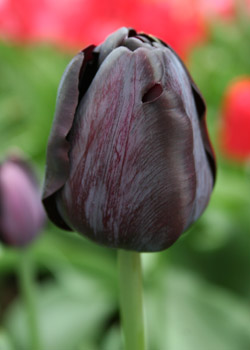Tulip Bulbs Information

Tulips are perhaps the most well-known spring blooming bulbs. Tulips add a large spectrum of vibrant, gorgeous colors to the spring garden and offer a long bloom time if planted accordingly. Ranging from short (6") to tall (32"), tulips provide varying heights and shapes. Whether you like the elegant lily-flowering tulips, the unique parrot tulips, or the double peony-like tulips, they are all sure to impress. Tulips also allow you to bring the beauty of your garden indoors since their sturdy stems and large flower heads make them ideal for cutting.
Tulip bulbs are native to areas with dry summers and cool winters. For best results, tulips should experience a cold period between 10 and 16 weeks prior to sprouting for proper blooming. Some varieties will grow and bloom reliably year after year (Darwin hybrids and botanical tulips), while other varieties are best when re-planted every year and treated as an annual. Tulips are also one of the best bulbs for indoor forcing, adding some color during the late winter to the indoors.
Plant Information
- Planting Time: Fall
- Bloom Time: Varies
- Hardiness Zone: 3-7
- Suitable Zone: 3-9
- Light Needs: Full Sun
Planting Tulips
- Tulips are typically planted in the fall. Their roots will form in fall and they will bloom in the early, mid, or late spring, depending on the variety.
- Choose a planting location that receives at least a half day's worth of sunlight and has well-drained soil.
- Space tulips 4-6" apart, depending on the specific variety. For example, Botanical Tulips will require less spacing since they are smaller in stature, while taller growing varieties will need to be spaced 4-6" apart. If desired, plant the bulbs in odd-numbered groups in larger holes for a "bouquet" effect.
- Plant tulip bulbs with the pointed side up, approximately 6-8" below the surface of the soil.
- Thoroughly soak the area with water once all of the bulbs have been planted. Water as needed while the plant is growing and blooming.
- After the flowers have died, remove the flower stem at the base to conserve energy. Allow the remaining foliage to yellow and die back as these leaves will continue to gather sunlight and make food for next year's blooms.
- Once the foliage has yellowed and dried, it may be removed by egently pulling it out of the soil. If the leaves do not easily pull away from the bulb, they are not ready to be removed. After you remove the foliage, your tulip bulbs will then be dormant and ready to "rest" until next year!